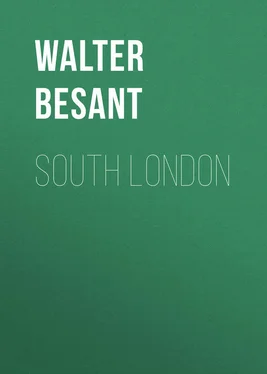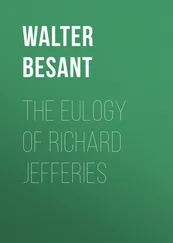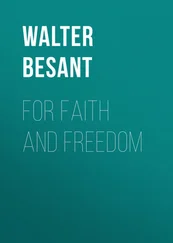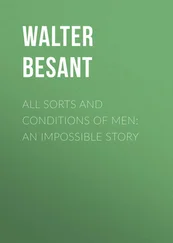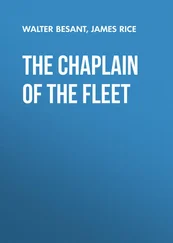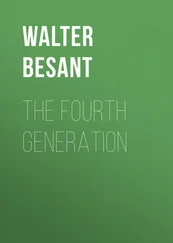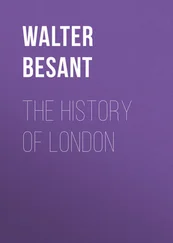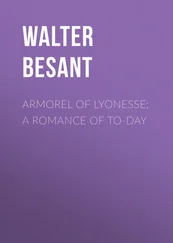Walter Besant - South London
Здесь есть возможность читать онлайн «Walter Besant - South London» — ознакомительный отрывок электронной книги совершенно бесплатно, а после прочтения отрывка купить полную версию. В некоторых случаях можно слушать аудио, скачать через торрент в формате fb2 и присутствует краткое содержание. Жанр: foreign_antique, foreign_prose, на английском языке. Описание произведения, (предисловие) а так же отзывы посетителей доступны на портале библиотеки ЛибКат.
- Название:South London
- Автор:
- Жанр:
- Год:неизвестен
- ISBN:нет данных
- Рейтинг книги:3 / 5. Голосов: 1
-
Избранное:Добавить в избранное
- Отзывы:
-
Ваша оценка:
- 60
- 1
- 2
- 3
- 4
- 5
South London: краткое содержание, описание и аннотация
Предлагаем к чтению аннотацию, описание, краткое содержание или предисловие (зависит от того, что написал сам автор книги «South London»). Если вы не нашли необходимую информацию о книге — напишите в комментариях, мы постараемся отыскать её.
South London — читать онлайн ознакомительный отрывок
Ниже представлен текст книги, разбитый по страницам. Система сохранения места последней прочитанной страницы, позволяет с удобством читать онлайн бесплатно книгу «South London», без необходимости каждый раз заново искать на чём Вы остановились. Поставьте закладку, и сможете в любой момент перейти на страницу, на которой закончили чтение.
Интервал:
Закладка:
THE ROYAL HOUSES OF SOUTH LONDON
All round London, like beads upon a string, were dotted Royal Houses, Palaces, and Hunting Places. On the north side were Westminster, Whitehall, St. James's, Kensington, Shene, Theobald's, Hatfield, Cheshunt, King's Langley, Hunsdon, Havering-atte-Bower, Stepney, the Tower; on the south side were Kennington, Eltham, Greenwich, Kew, Hampton, Windsor, a tradition attaching to Streatham, and the House of Nonesuch, built by Henry VIII. at Cheam. Most of these royal houses are now clean forgotten. Eltham preserves some ruins left of Edward IV.'s buildings; it still shows the moat and the old bridge, and the line of its former wall; but tradition, which has quite forgotten its memories of the Edwards and the Tudors, describes it as the Palace of King John. The sailors – now, alas! also gone – have deprived Greenwich of Edward VI. and Elizabeth. Theobald's is gone altogether, Nonesuch is wholly cleared away. Of Kennington, of which I have to speak in this place, not one stone remains upon another; not a vestige is above ground; the people on the spot know of no remains underground; its very memory is gone and forgotten: there is not even a tradition left, although part of the ruins were still standing only a hundred years ago.
The reason for this oblivion is not far to seek. The palace was deserted; it was pulled down before 1607 – Camden says that even then there was not a stone remaining – there was not a single house within half a mile in every direction. There was no one, when the last stones had been carted away, left to remember or to remind his children that there had been a palace on this spot. Another house was built here, but no tradition attached to it. Two hundred years passed, and then came the destruction of the second house; in 1745 there was not even a cottage near the spot. This being so, it is not difficult to understand why the site was forgotten.
The moat remained, however, and apparently some of the substructures; a building of stone and thatch, part of the offices of the palace, also stood. They called it the 'Long Barn,' and when the distressed Protestants were brought over here in 1700 as many as the place would hold were crammed into the Long Barn. Market gardens lay all over the country between Kennington Road and Lambeth, and on the site of the palace there was not a single person left who could carry on the tradition of the king's house that once stood here. Roque, the map-maker of 1745, knew nothing about it. In 1795 the Long Barn was taken down. At the beginning of the century houses began to rise here and there; streets began to be formed: at least three streets cross the gardens and the site of the palace; but there is not one tradition of a place which, as we shall see, was full of history for six hundred years. 'Is this fame?' might ask the king who crowned himself here, the king who died here, the king who was brought up here, the kings who kept their Christmas feast here, the kings who here received their brides, held Parliament, and went out a-hunting.
The king who crowned himself here was Harold Harefoot, son of Cnut – that is to say, it was at 'Lambeth,' and there was no other house at Lambeth.
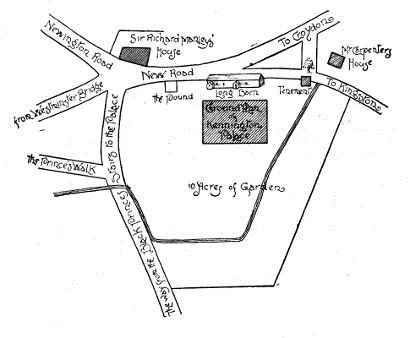
SKETCH MAP
The king who died in this house was that young Dane who appears to have been an incarnation of the ideal Danish brutality. He dragged his brother's body out of its grave and flung it into the Thames; he massacred the people of Worcester and ravaged the shire; and he did these brave deeds and many others all in two short years. Then he went to his own place. His departure was both fitting and dramatic. For one so young it showed with what a yearning and madness he had been drinking. He went across the river – there was, I repeat, no other house in Lambeth except this, so that it must have been here – to attend the wedding of his standard-bearer, Tostig the Proud, with Goda, daughter of the Thane Osgod Clapa, whose name survives in his former estate of Clapham. A Danish wedding was always an occasion for hard drinking, while the minstrels played and sang and the mummers tumbled. When men were well drunken the pleasing sport of bone throwing began: they threw the beef bones at each other. The fun of the game consisted in the accident of a man not being able to dodge the bone which struck him, and probably killed him. Archbishop Alphege was thus killed. The soldiers had no special desire to kill the old man: why couldn't he enter into the spirit of the game and dodge the bones? As he did not, of course he was hit, and as the bone was a big and a heavy bone, hurled by a powerful hand, of course it split open his skull. One may be permitted to think that perhaps King Hardacnut, who is said to have fallen down suddenly when he 'stood up to drink,' did actually intercept a big beef bone which knocked him down; and as he remained comatose until he died, the proud Tostig, unwilling to have it said that even in sport his king had been killed at his wedding, gave out that the king fell down in a fit. This, however, is speculation.
Forty years after this event, when Domesday Book was compiled, the place was in the possession of a London citizen, Theodric by name and a goldsmith by trade. It was still a royal manor, because the goldsmith held it of Edward the Confessor. It was then valued at three pounds a year. It is impossible to arrive at the meaning of this valuation. We may compare it with that of other estates, with the rental and price of other lands, with the cost of provisions, and with the wages and pay of servants and officers; and when we have done all, we are still very far from understanding the value of money then or at any subsequent time. There are, you see, so many points which the writers on the value of money do not take into consideration. There is the price of bread; but then there were so many kinds of bread – wheaten bread, barley bread, oat bread, rye bread; and how much bread did a family of the working class consume? Flesh, fish, fowl, but how much of either did the working classes enjoy? Rent? But on the farms the "villains" paid no rent. There is, in a word, not only the market prices that have to be considered, but the standard of comfort – always a little higher than the practice – and the daily relations of the demand to the supply. So that when we read that this manor of Kennington was worth three pounds a year we are not advanced in the least. As most of the land was still marshy and useless, we may understand that the value was low.
We next hear of Kennington in 1189, when King Richard granted it on lease, or for life, to Sir Robert Percy with the title of Lord of the Manor. Henry III. came here on several occasions; here he held his Lambeth Parliament. He kept his Christmas here in 1231. Great was the feasting and boundless the hospitality of this Christmas, at which this king lavished the treasures of the State.
The site of the palace is indicated in the accompanying map. If you walk along the Kennington Road from Bridge Street, Westminster, you presently come to a place where four roads meet, Upper Kennington Lane on the left, and Lower Kennington Lane on the right; the road goes on to the Horns Tavern and Kennington Park. On the right-hand side stood the palace. In the year 1636 a plan of the house and grounds was executed; but by that time the mediæval character of the place was quite forgotten. It was a square house, probably Elizabethan; the home of King Henry III. at some time or other had been completely taken away. The site of the moat, however, was left, and there was still standing the 'Long Barn.' The only way to find out what the palace really was in the thirteenth or fourteenth century is to compare it with another palace built under much the same conditions, and intended to serve the same purpose. Fortunately there still stand, some miles to the east of Kennington, at Eltham, important remains of such a contemporary palace, with a description of the place as it was before it was allowed to fall into ruins.
Читать дальшеИнтервал:
Закладка:
Похожие книги на «South London»
Представляем Вашему вниманию похожие книги на «South London» списком для выбора. Мы отобрали схожую по названию и смыслу литературу в надежде предоставить читателям больше вариантов отыскать новые, интересные, ещё непрочитанные произведения.
Обсуждение, отзывы о книге «South London» и просто собственные мнения читателей. Оставьте ваши комментарии, напишите, что Вы думаете о произведении, его смысле или главных героях. Укажите что конкретно понравилось, а что нет, и почему Вы так считаете.
